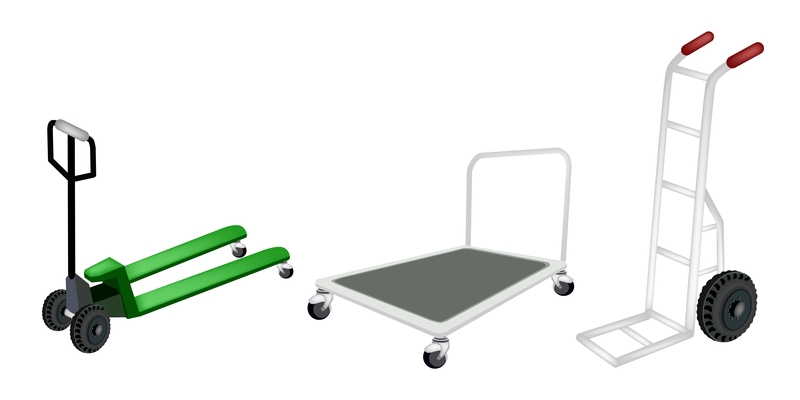Smart Ways to Store Your Idle Freezer with Care
Posted on 22/05/2025
Smart Ways to Store Your Idle Freezer with Care
If you find yourself with a freezer that won't be used for a while--perhaps due to a move, a home renovation, or simply because you're upgrading your appliance--it's important to store an idle freezer properly. Mishandling can result in mold growth, odors, and costly damage to the unit. This comprehensive guide highlights smart ways to store your idle freezer, ensuring that when you need it again, it's clean, efficient, and ready to chill.
Why Careful Freezer Storage Is Essential
- Prevents Mold and Mildew: Improper storage fosters moisture build-up, leading to unpleasant smells and visible mold.
- Maintains Appliance Efficiency: Taking the right steps ensures that your freezer runs optimally when brought back into service.
- Protects Interior and Exterior: Thoughtful storage protects gaskets, shelves, and the finish from damage.
- Extends Appliance Lifespan: Caring for your freezer reduces wear and tear, prolonging its usable years.
Initial Steps: Clean Thoroughly Before Storage
The first step in preparing your refrigerator freezer for storage is thorough cleaning. Leftover food particles or moisture can breed bacteria and cause permanent odors.
- Unplug and Defrost: Switch off your freezer and allow all ice to melt. Place towels around the base to catch dripping water.
- Remove Shelves and Drawers: Take out removable components for separate cleaning.
- Clean Interior and Accessories: Use a solution of warm water and mild dish soap. Avoid harsh chemicals that can damage plastic.
- Sanitize: For extra protection, wipe down surfaces with a vinegar and water mixture to neutralize lingering microbes.
- Dry Completely: Leave the door open for several hours (or overnight) to ensure all moisture evaporates.
Preparing the Freezer for Safe Storage
Proper preparation is vital when considering how to store your unused freezer for weeks or months. Leaving your appliance in a rush may lead to irreversible internal and external damage.
- Secure Cords and Accessories: Bundle the power cord and secure it with a twist tie or Velcro strap. Place it inside the unit or tape it to the back to prevent tripping hazards.
- Keep Doors Slightly Open: Prevent foul odors and mold by propping the door open a fraction. Some freezers have a built-in 'store' feature to hold the door ajar; if not, use a towel or small object to wedge the door open.
- Store Shelves and Drawers: If you don't want to leave shelves inside, wrap them in bubble wrap and store nearby in a labeled box.
- Deodorize: For extra freshness, place an open box of baking soda or activated charcoal inside. These absorb residual odors during storage.
Choosing the Right Storage Environment
Where you keep your idle freezer has a major impact on its condition. The best storage practices for idle freezers include picking a location with the right temperature and humidity levels.
- Climate Control: Preferably, store the freezer indoors where temperatures are stable--between 50?F and 85?F (10?C-29?C).
- Avoid Damp Areas: Basements and garages may invite rust or corrosion if they're too humid. If you must use such spaces, consider a dehumidifier.
- Keep Off Direct Sunlight: UV rays and heat degrade exterior finish and warp plastic components.
- Upright Is Best: Always store your freezer in its upright position. Laying it down can cause compressor oil to leak into parts it shouldn't, risking malfunction.
- Provide Air Circulation: Leave a few inches between the appliance and the wall to ensure proper ventilation.
Additional Tips: Smart Freezer Storage Solutions
With your freezer cleaned and the location prepared, a few extra steps will help you store your dormant freezer with care.
- Protect from Pests: Rodents and insects are attracted to small crevices. Seal vents or gaps with mesh or steel wool, especially if storing in an outbuilding.
- Use a Freezer Cover: A purpose-made cover keeps dust, dings, and moisture at bay. If using a tarp, be sure it is breathable to avoid trapping humidity.
- Label the Appliance: Attach a visible label indicating "Out of Use - DO NOT PLUG IN" to avoid accidental damage or energy waste.
- Check on the Unit: Periodically inspect your freezer for signs of moisture, pest intrusion, or odor buildup. Wipe down as needed and refresh baking soda or charcoal.
How Long Can a Freezer Sit Unused?
Most freezers can be left unplugged for months if stored properly. The exact duration depends on storage conditions and how well you've prepped the unit. Regular checks--every few months--are recommended for long-term storage.
Reviving an Idle Freezer
When the time comes to use your freezer again, a little care goes a long way:
- Inspect Interior and Exterior: Check for visible mold, mildew, or rust. Clean or dry as necessary.
- Reconnect Components: Replace shelves and drawers after wiping them down.
- Plug-In Properly: Place the freezer upright at least a few hours before reconnecting to power, especially if it was moved lying down.
- Air Out: Let the freezer run empty for a few hours to cool and dispel any musty smells before adding food.
Frequently Asked Questions (FAQ)
-
Can I store a freezer in a cold garage?
Most modern freezers tolerate cold, but if the temperature drops below freezing, components might malfunction. Read your manufacturer's advice. -
Should I leave the freezer door open when in storage?
Yes. Keeping the door ajar prevents moisture and mold buildup. Use spacers and deodorants like baking soda for added freshness. -
How do I keep pests away from my idle freezer?
Plug vents, avoid storing food remnants, and check for gaps in the storage location. Using steel wool can help deter rodents. -
What's the risk of storing a freezer on its side?
Laying a freezer down can cause compressor oil migration, damaging the unit. Always store upright if possible. -
How often should I check on my stored freezer?
Inspect at least every three months for odors, leaks, and pests, especially if placed in a garage, shed, or seasonal home.
Environmental Considerations for Freezer Storage
As appliances age, responsible use and maintenance become increasingly important from an environmental standpoint. Storing your unused freezer in an eco-friendly way helps reduce waste and energy consumption. Keep these points in mind:
- Unplug Completely: Avoid phantom energy drain by ensuring the unit isn't plugged in during storage.
- Non-Toxic Cleaning: Prefer natural, non-abrasive cleaning agents like vinegar and baking soda to protect groundwater.
- Proper Disposal: If the freezer is no longer functional, follow local regulations for appliance recycling to recover valuable materials and gases.
Conclusion: Store Your Idle Freezer the Smart Way
Properly storing an idle freezer involves more than just unplugging and forgetting about it. The key steps--including thorough cleaning, ensuring dryness, propping the door open, guarding against pests, choosing a stable environment, and periodic inspection--preserve your appliance and prevent future headaches. By following these smart ways to store your idle freezer with care, you'll guarantee your investment is protected, safe, and ready for use whenever you need extra cold storage again.
For more appliance care tips and best storage practices, keep exploring our guides and enjoy peace of mind knowing your home investments are in the best hands!
```








